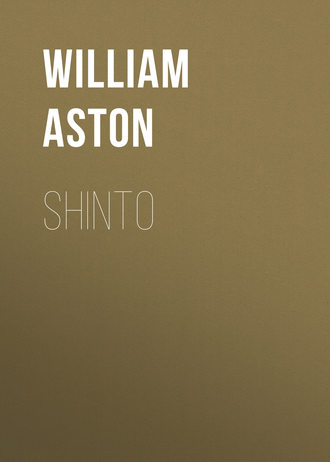 полная версия
полная версияShinto
305
Nihongi, ii. 82.
306
See above, p. 294.
307
Koyane. Hirata speaks with scorn of the Chinese methods of divining current in Japan in later times, in which no invocation of the Gods was used. Sometimes other Gods, and even Buddhas, were invoked.
308
"The King of Babylon stood at the parting of the way, at the head of the two ways, to perform divination." – Ezekiel xxi. 21.
309
Pausanias says that in ancient Greece the inquirer, after asking his question of the God and making his offering, took as the divine answer the first words he might hear on quitting the sanctuary.
310
The date of the festival of the Sahe no Kami.
311
See above, p. 193.
312
The Kami-yori-ita (God-resort-board), struck in later times to bring down the Gods, is believed to be a substitute for this harp.
313
It is not known who these Gods were.
314
Smaller gohei used in the harahi ceremony.
315
Weston, 'Mountaineering in the Japanese Alps,' p. 307. See also Index, Inugami; and Mr. Chamberlain's 'Things Japanese,' third edition, p. 110.
316
Compare the story of Gideon's fleece in Judges vi. 37. See also Nihongi, I. 237, and Ch. K. 194.
317
'Sociology,' i. 154.
318
See Mr. P. Lowell's 'Occult Japan,' p. 36.
319
Kannushi.
320
Saniha (pure court) is explained as the official who examines the utterances prompted by the Deity.
321
At the battle of Dannoüra, in 1184.
322
In-musubi, a Chinese practice.
323
A Buddhist religious implement.
324
A Buddhist deity. The incense is also Buddhist.
325
See above, p. 332.
326
An excellent account of a Japanese hypnotic séance is given in Mr. Weston's 'Mountaineering in the Japanese Alps,' p. 282.
327
See above, p. 350.
328
"Antiquity regarded the soul of woman as more accessible to every sort of inspiration, which also, according to ancient opinion, is a πάσχεον." – Müller, 'Sc. Myth.,' p. 217.
329
See above, p. 206.
330
See above, p. 344.
331
For an account of Japanese Buddhism, consult Murray's 'Japan,' or the more comprehensive description in Griffis's 'Religions of Japan.'
332
See above, p. 175.
333
The novelist Bakin, who cannot be charged with priestcraft, says: "Shinto reverences the way of the Sun; the Chinese philosophers honour Heaven; the teaching of Shaka fails not to make the Sun a deity. Among differences of doctrine the fundamental principle is the same."
334
In the old Shinto, Ne no kuni, or Hades, is not a place of punishment for the wicked. Here it stands for the Jigoku, or Hell, of the Buddhists.
335
That is, Nature-a Chinese idea.
336
This is Chinese.
337
A Buddhist designation.
338
And therefore unclean.
339
See above, p. 179.
340
As Sugahara himself was.
341
See above, p. 155.
342
See above, p. 177.
343
Alluding to the inner and outer shrines of Ise.
344
For a full account of the Revival of Pure Shinto, see Sir E. Satow's papers contributed to the T. A. S. J. in 1875. Our knowledge of Shinto dates from this time.
345
An interesting account of this sect is given in a paper by Dr. Greene in the T. A. S. J., December, 1895.
346
See papers by Dr. Greene and Rev. A. Lloyd in the T. A. S. J., 1901.



